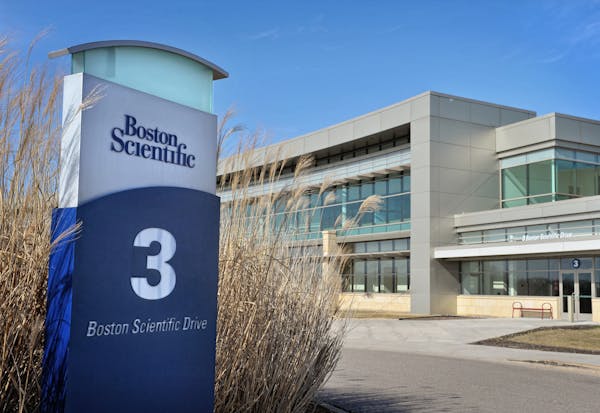As the inventor of a solution that preserves eye tissue for surgery, Bloomington's Dr. Richard Lindstrom has given sight to legions of people worldwide and become highly sought after for speeches and consulting deals.
He has been handsomely rewarded for his work.
Lindstrom received $330,452 in payments just during the last five months of 2013 from companies whose ophthalmology products he prescribes for patients, according to a newly published federal database.
The new Open Payments data has injected hard numbers into a national debate over whether large checks can lead doctors to use products from a particular company, or whether companies are simply collaborating with doctors for medical advancement.
"I can imagine situations where this might generate behavior that is not in the patients' best interest," said Lindstrom, founder and attending surgeon at Minnesota Eye Consultants in Bloomington and a former president of influential ophthalmology groups. "But as long as the physician uses technology regardless of whether or not they have consulted on it, then I don't see the issue as being a negative."
Critics charge that payments from industry can corrupt medical judgment by steering doctors toward certain therapies or introducing bias into clinical trials.
Altogether, the U.S. Centers for Medicare and Medicaid Services have for the first time disclosed more than 4 million payments covering $4.6 billion that was paid by device and drug companies to doctors and teaching hospitals.
More than 17,000 Minnesota doctors and hospitals received payments totaling nearly $9.5 million during the five-month period — and that's just from the database that included names. Another $1.8 million in payments to Minnesota providers was published without the identities made clear in the data release.
The statistics cover only the last five months of 2013. Future annual releases will cover full years. But even the partial-year data is prompting frank debate about when money from companies crosses the line from education to something less savory.
"Some of the payments are about research. But many of them are flat-out about marketing and selling things that may or may not benefit patients," said Harvard researcher and University of Minnesota graduate Eric Campbell, whose work has focused on physician conflicts of interest.
Past research has found that while most doctors don't think they are influenced by industry payments, they believe their peers are. That's part of the reason the Affordable Care Act required the first-ever publication of a national database on industry payments.
The issue rose to prominence in Minnesota about eight years ago, when University of Minnesota spine surgeon Dr. David Polly was widely criticized and targeted in a congressional investigation for failing to report some of the $1.2 million he received from Fridley-based Medtronic. All of Minnesota's large devicemakers have since paid multimillion-dollar settlements to the Justice Department to resolve whistleblower lawsuits alleging that they paid kickbacks to doctors to prescribe their products.
Those device cases came after renewed interest in payments from drug companies that spurred a Minnesota law disclosing those arrangements and banning gifts from pharma companies. Ethicists are still debating a 2003 case in which a patient died during a University of Minnesota clinical trial for the antipsychotic drug Seroquel that included unusually lucrative payments to the university's Psychiatry Department.
Ideally, the new federal data would be easy to manipulate for patients and clinical trial participants, but that is not the case. The software behind the data release was designed by CGI Federal, the same company that launched the much-criticized Obamacare sign-up site, healthcare.gov.
Users of the Open Payments site immediately groused about the complexity of the data, which was packaged in seven separate files with abstruse titles and dozens of fields of information.
And a lot is missing. Federal officials redacted doctors' and hospitals' names from about 40 percent of the files because the agency couldn't independently verify the providers' identities. An additional 190,000 records were withheld under an exception to protect commercial secrets in ongoing research. Some 9,000 payments totaling $514 million were kept secret after doctors disputed them. Federal officials said much of that data should be released next June.
Specialists top list
Several trends emerged in the information that became available. In particular, orthopedics, ophthalmology and spinal care placed highly on the list for Minnesota doctors.
Seven of the 20 most highly paid doctors on the list work at the Twin Cities Spine Center, on the campus of Abbott Northwestern Hospital in south Minneapolis. A spokesperson with the spine center didn't return calls for comment.
The highest-compensated Minnesota doctor in the database is an orthopedic surgeon and inventor. Dr. Daniel Berry, a former department chair at the Mayo Clinic in Rochester, received a total of $911,745 in industry payments.
The money came primarily from two royalty payments of more than $400,000 each that he received for his work in inventing a new technology that helps artificial-hip devices bond better with bone.
Like many doctors, Berry was only allowed to collect a fraction of the total that was reported given to him in the database. The royalty payments from Johnson & Johnson's DePuy Synthes division, which makes orthopedic devices, went directly to Mayo, which was required by law to share a fraction of the money with Berry. The system doesn't collect royalties on devices invented at Mayo and used on the health system's own patients.
"Relationships with industry are very common, and Mayo encourages and supports relationships with many companies," said Dr. Richard Ehman, vice chairman of the conflict-of-interest review board at Mayo. "We have policies that make sure they are the right kinds of relationships."
Conflict policies
Both Mayo and the University of Minnesota — which employs three of the state's 20 highest compensated doctors in the database — have policies that prohibit a researcher from working as principal investigator of a clinical study if they're also receiving money from the manufacturer.
The university requires about 10,000 staff members to fill out conflict-of-interest disclosures. Typically, several dozen of them rise to the level of requiring formal plans to mitigate the potential for bias, said Lynn Zentner, director of institutional compliance at the university.
Asked whether university officials have double-checked last week's disclosures against the forms filled out by staff members, Zentner said, "We are the midst of that right now."
Lindstrom, the surgeon-inventor at Minnesota Eye Consultants, said he's a longtime proponent of transparency. He said he always discloses the companies that pay him before he gives speeches, and the clinic is assiduous in making sure that patients are told when they're getting therapies involving companies that pay him.
"I think it's fine. I'm personally quite open about it," he said. "This is an area that is a bit in flux. It can be a challenge to know what is the ideal way to manage these kinds of conflicts, but starting with disclosure is appropriate."
Joe Carlson • 612-673-4779
Twitter: @_JoeCarlson

Want to share info with the Star Tribune? How to do it securely

A Minnesota field guide to snow shovels: Which one's best?
Sign up for Star Tribune newsletters

